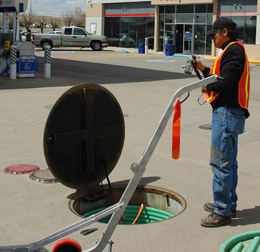 In Washington State, the Department of Ecology’s (DOE) Underground Storage Tank (UST) program plays an instrumental role in regulating fuel storage tanks. Every UST system must be registered and inspected regularly to guarantee safe operations in compliance with state and federal regulations.
In Washington State, the Department of Ecology’s (DOE) Underground Storage Tank (UST) program plays an instrumental role in regulating fuel storage tanks. Every UST system must be registered and inspected regularly to guarantee safe operations in compliance with state and federal regulations.
The frequency of inspections depends on various factors, such as the type of fuel storage tank, its volume, and its age. To illustrate, tanks containing less than 1,100 gallons of petroleum are required to be inspected every three years, while tanks with a capacity exceeding 1,100 gallons or those over 30 years old necessitate an annual inspection.
During these inspections, trained personnel meticulously check tanks for potential hazards, such as leaks and corrosion. In addition, the tank’s equipment, including pumps and gauges, is thoroughly examined to ensure proper functionality.
While adhering to the DOE’s regulations is crucial, organizations may also have internal policies and procedures for fuel storage tank inspection and maintenance. For those responsible for compliance, staying updated with these internal policies, alongside state and federal regulations, is vital for full compliance.
Here’s a snapshot of the annual tasks required by the Department of Ecology:
- Leak Detector Test
- Tank Monitor Certification with ATG Probe Inspection
- Line Tightness Test
- Documented Annual Walk Through on Dept of Ecology Forms
And don’t forget, overflow and spill bucket inspections must be carried out every three years.
Maintaining compliance with DOE’s regulations is not merely a legal requirement but a commitment to safety and environmental stewardship. Here at FuelCare, we stand by these values, recognizing that effective fuel tank management is key to ensuring operational efficiency across diverse industries.
By understanding and adhering to these guidelines, organizations can ensure their fuel storage tanks remain in optimal condition, thereby minimizing potential risks and disruptions.
For more information visit: EPA Underground Storage Tanks and WA State Dept of Ecology USTs
